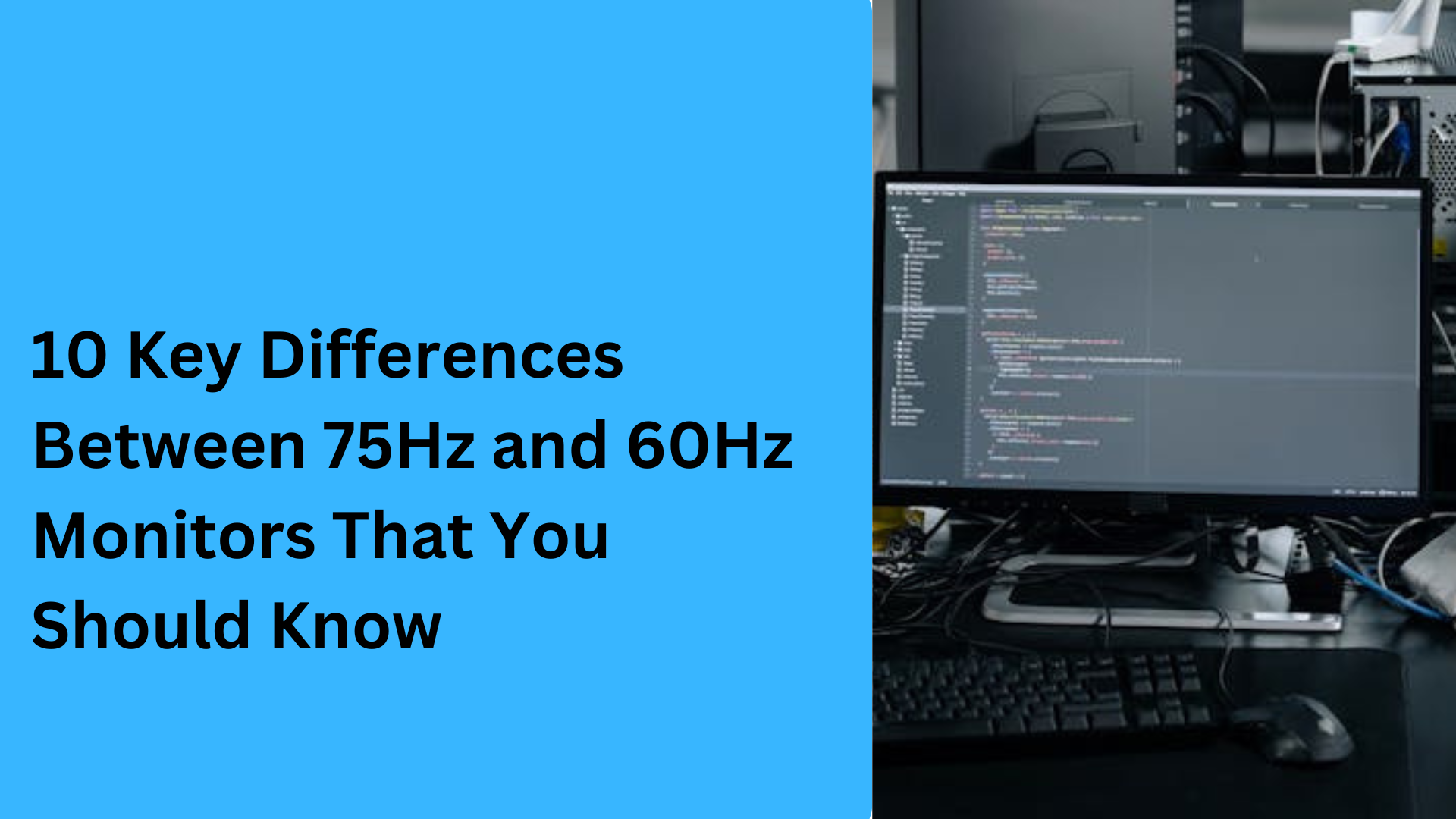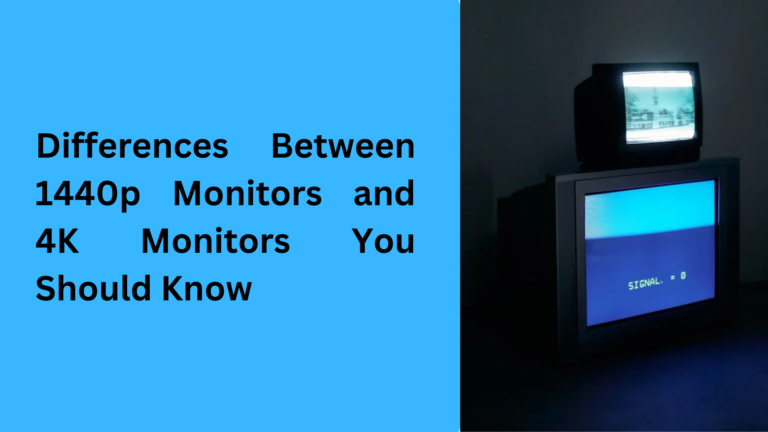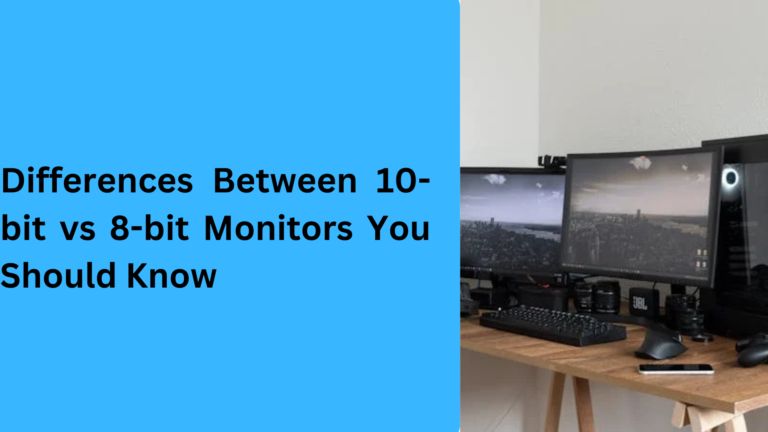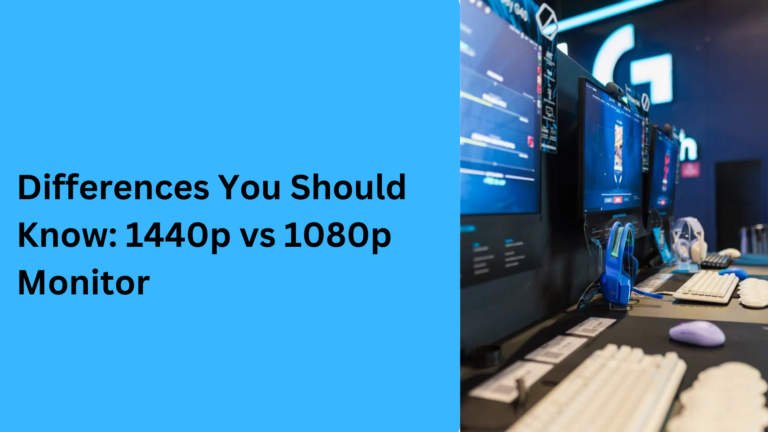10 Key Differences Between 75Hz and 60Hz Monitors That You Should Know
When choosing a monitor, one of the main factors to consider is its refresh rate. The refresh rate determines how many times per second the display updates the image, and it’s measured in Hertz (Hz). The two common options available are 60Hz and 75Hz monitors. Understanding the differences between 75Hz and 60Hz monitors can help you make a more informed decision. Below, we’ll break down the five key differences between these two refresh rates and how they affect your overall experience.
1. Difference in Smoothness: 75Hz vs 60Hz Refresh Rate for Gaming
For gaming, having a smooth visual experience is crucial. While both 60Hz and 75Hz monitors offer decent performance, 75Hz monitors provide a noticeably smoother experience. This is because a 75Hz refresh rate updates the screen 75 times per second, which reduces motion blur and makes fast-moving visuals more fluid compared to a 60Hz monitor, which refreshes only 60 times per second. This difference in refresh rates may not be drastic, but it can make a significant impact in fast-paced games.
If you’re a casual gamer, a 75Hz refresh rate monitor might give you that extra edge without the higher price of more expensive gaming monitors. The extra 15Hz can also lead to less screen tearing and stuttering, especially when paired with a good graphics card.
2. Response Time: Does a 75Hz Monitor Have Better Response Time Than 60Hz?
Though response time and refresh rate are different specs, a higher refresh rate often correlates with better responsiveness. In general, 75Hz monitors are designed for slightly faster response times compared to 60Hz monitors, which can reduce input lag and enhance the gaming experience. This means that your actions on the keyboard or mouse will be reflected on the screen faster, making a 75Hz monitor a better choice for smoother gameplay.
When playing fast-action games or even watching high-paced movies, a 75Hz monitor will typically offer crisper visuals and more responsive performance than a 60Hz model.
3. Clarity and Visual Quality: 75Hz Monitor Better for Productivity?
If you’re using your monitor for everyday tasks such as browsing, watching videos, or working on office applications, both 60Hz and 75Hz monitors can handle these activities well. However, 75Hz monitors offer slightly better clarity in fast-moving scenes, whether you’re watching videos or dealing with graphics-heavy tasks.
In terms of productivity, if you’re using the monitor for design, editing, or even just moving between multiple windows quickly, the additional refresh rate of 75Hz can reduce the strain on your eyes. This can make a difference if you spend long hours in front of the screen, where smoother transitions and sharper images lead to better visual comfort.
4. Price Difference: Is a 75Hz Monitor Worth the Extra Cost Over 60Hz?
One of the key factors when deciding between a 60Hz vs 75Hz monitor is the price. Generally, 60Hz monitors are more affordable and are the standard choice for everyday users who do not need higher refresh rates. On the other hand, 75Hz monitors tend to be slightly more expensive, but the price difference is often not too significant.
If you’re looking for a budget-friendly option, 60Hz might suit your needs. However, the additional cost of a 75Hz monitor is usually justified by the better performance, especially if you play games or work with graphic design. Many people find that investing in a 75Hz monitor provides a better overall user experience without a hefty price increase.
5. Power Consumption: Does a 75Hz Monitor Use More Power Than 60Hz?
Another factor that people often overlook is power consumption. A 75Hz monitor typically uses slightly more power than a 60Hz monitor due to the higher refresh rate. However, the difference is minimal and usually not enough to have a noticeable impact on your electricity bill.
If you are energy-conscious or running multiple monitors, you might want to consider how much time you spend using the monitor at full refresh rates. For most users, the power consumption difference between 60Hz and 75Hz monitors will be negligible, so it shouldn’t be a major deciding factor.
6. Compatibility: Is a 75Hz Monitor Compatible With All Devices?
One major consideration when choosing between a 75Hz monitor and a 60Hz monitor is compatibility with your devices. While 60Hz monitors are universally supported by most computers, laptops, and consoles, some older devices may not support the higher refresh rate of 75Hz.
For example, older GPUs or lower-end laptops may not output at 75Hz, even if the monitor supports it. In contrast, modern PCs and gaming consoles like the PlayStation 5 or Xbox Series X can take full advantage of a 75Hz refresh rate. Before purchasing a 75Hz monitor, check whether your graphics card or system can handle the higher refresh rate. Otherwise, you may end up using the monitor at 60Hz, negating its advantages.
7. Gaming Experience: Which Monitor is Better for Casual and Competitive Gaming?
When it comes to gaming, 60Hz monitors provide a solid experience for casual gamers who play slower-paced games such as strategy or puzzle titles. However, for faster-paced games like first-person shooters, racing games, or action-adventure titles, the extra frames offered by a 75Hz refresh rate can provide a competitive edge.
A 75Hz gaming monitor reduces motion blur and screen tearing more effectively than a 60Hz model, creating smoother visuals and making it easier to track fast-moving objects. Competitive gamers looking for an affordable option that delivers decent performance will often prefer 75Hz monitors over 60Hz ones.
8. Eye Comfort: Does a 75Hz Monitor Reduce Eye Strain Compared to 60Hz?
For people who spend long hours in front of a monitor, eye strain is a common issue. A 75Hz monitor offers better eye comfort compared to a 60Hz monitor, particularly for those who engage in tasks involving continuous motion, like video editing, gaming, or even web browsing.
The smoother transitions and reduced flicker of a 75Hz refresh rate can help minimize strain on the eyes, making it a better option for extended use. Additionally, pairing a 75Hz monitor with features like blue light filters and anti-glare coatings can further enhance comfort and reduce fatigue during prolonged sessions.
9. Refresh Rate Scaling: Can You Tell the Difference Between 60Hz and 75Hz?
A common question when comparing 75Hz vs 60Hz monitors is whether the difference is noticeable. While the difference may be subtle to the average user during everyday tasks, it becomes more apparent during high-motion activities like gaming or watching fast-paced videos.
The smoother visuals of a 75Hz refresh rate can make a big difference in dynamic scenarios, reducing stuttering and delivering a more immersive experience. That said, if you’re upgrading from a 30Hz or older monitor, even a 60Hz monitor will feel like a massive improvement. The jump to 75Hz is most beneficial for users who demand a slightly enhanced performance without breaking the bank.
10. Future-Proofing: Is a 75Hz Monitor a Better Long-Term Investment?
As technology advances, higher refresh rates are becoming the new standard. While 60Hz monitors remain widely used, a 75Hz monitor is a better investment for future-proofing your setup. This is especially true if you plan to upgrade your GPU or gaming rig later, as it allows you to take advantage of better performance.
In addition, newer software, games, and applications are optimized to perform well with higher refresh rates, making 75Hz monitors a more versatile choice in the long run. Even if you’re not a gamer, the enhanced smoothness and responsiveness of a 75Hz monitor can improve your overall experience across various tasks as technology evolves.
FAQs: Understanding the Differences Between 75Hz and 60Hz Monitors
1. What is the difference between 75Hz and 60Hz monitors for gaming?
The primary difference lies in the refresh rate. A 75Hz monitor refreshes the screen 75 times per second, while a 60Hz monitor refreshes it 60 times per second. This makes 75Hz monitors better for gaming, especially for fast-paced games, as they reduce motion blur, screen tearing, and provide a smoother visual experience compared to 60Hz monitors.
2. Is a 75Hz refresh rate monitor worth upgrading from 60Hz for casual users?
If you primarily use your monitor for tasks like web browsing, video watching, or office work, the upgrade from 60Hz to 75Hz may not be essential. However, a 75Hz refresh rate monitor offers smoother transitions and slightly better clarity, which can improve comfort for those who spend long hours on the screen or want a minor performance boost without investing in higher refresh rates.
3. Can my PC or laptop support a 75Hz monitor if I’m currently using a 60Hz monitor?
Most modern PCs and laptops can support a 75Hz monitor refresh rate, but you need to check your GPU and display output settings. Ensure that your system can deliver 75Hz at the resolution you plan to use. Some older hardware or budget laptops may only support 60Hz, even if the monitor can handle 75Hz.
4. Which is better for eye strain: 75Hz or 60Hz monitors?
A 75Hz monitor is better for reducing eye strain, particularly during activities that involve a lot of motion, such as gaming or video editing. The smoother transitions and reduced flickering at 75Hz make it easier on the eyes during prolonged usage compared to a 60Hz monitor. Pairing it with features like blue light filters further enhances visual comfort.
5. Are 75Hz monitors a good choice for budget gaming compared to 60Hz monitors?
Yes, 75Hz monitors are an excellent choice for budget gaming. They offer a smoother gaming experience than 60Hz monitors without the higher costs of 120Hz or 144Hz displays. For casual gamers or those upgrading from older monitors, a 75Hz monitor provides a noticeable improvement in gameplay quality, making it a popular middle-ground option.
These FAQs address common concerns while incorporating long-tail keywords like “difference between 75Hz and 60Hz monitors for gaming”, “is 75Hz better for eye strain”, and “best budget gaming monitor 75Hz vs 60Hz” to help users make an informed decision.




